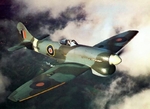Tempest
| Country | United Kingdom |
| Manufacturer | Hawker Aviation |
| Primary Role | Fighter |
| Maiden Flight | 2 September 1942 |
Contributor: C. Peter Chen
ww2dbaseWith a more efficient wing, a more aerodynamic nose, and a larger fuel tank, the design of these originally named Typhoon II fighters by Sidney Camm of Hawker Aviation was so welcomed by the British Air Ministry that specification F.10/41 was issued specifically to fit the design. They were renamed Tempest in Jan 1942, and the first Tempest prototype flew on 2 Sep 1942. The variation designated as Tempest V became the main production model, with the first one rolling off the production line on 21 Jun 1943. They were deployed to squadrons by Apr 1944, and by Jun 1944 they were already being regarded as an effective defensive weapon against German V-1 flying bombs; by the end of the war, they claimed 638 of the 1,846 flying bombs destroyed by aircraft. They were equally as effective against other targets; in Dec 1944, they claimed 52 German fighters and 89 locomotives at the loss of 20 Tempests. They also had a share of kills of German jets, leading to Luftwaffe pilot Hubert Lange's comment that the "Messerschmitt Me 262's most dangerous opponent was the British Hawker Tempest — extremely fast at low altitudes, highly-maneuverable and heavily-armed."
ww2dbaseSource: Wikipedia.
Last Major Revision: Aug 2006
Tempest Timeline
| 2 Sep 1942 | The first Hawker Tempest Mk V (HM595) aircraft flew for the first time. One of the fastest fighters of the war, the Tempest entered service in Apr 1944. |
| 24 Jun 1944 | 56 Squadron at RAF Newchurch in Kent, England, United Kingdom received its first Tempest aircraft and underwent intensive training on flying them. |
| 23 Sep 1944 | A V-1 flying bomb over flew the town of Newmarket, Suffolk, England, United Kingdom and crashed near Burwell in Cambridgeshire. The pilot, at the rank of flight officer, of the 501 Squadron had been chasing the bomb and had reached overtaking speed when the engine of his Tempest aircraft seized up. He had seconds to gain a little height and turn to the west to avoid the marshlands and bale out. He saw the aircraft crash into a barn and explode whilst he landed in a cherry tree outside the Leather Bottle Inn. It was there that he was rescued by a Royal Engineer Officer before being held in a Police Station for 2 hours awaiting proper identification. The fault in the Tempest aircraft was traced to an air lock when fuel tanks were switched over. |
| 12 Oct 1944 | Robert Cole of No. 3 Squadron RAF, flying a Tempest V fighter, shot down a Me 262 jet fighter which was escorting bombers of German Kampfgeschwader 51. This was the first victory of a jet aircraft by a Tempest fighter. The German pilot, Unteroffizier Edmond Delatowski, bailed out and survived. |
SPECIFICATIONS
Tempest V
| Machinery | One Napier Sabre IIB liquid-cooled H-24 sleeve-value engine rated at 2,400hp |
| Armament | 4x20mm Mark II Hispano cannons, 2x227kg or 454kg bombs, 8x75mm rockets |
| Crew | 1 |
| Span | 12.49 m |
| Length | 10.26 m |
| Height | 4.90 m |
| Wing Area | 28.00 m² |
| Weight, Empty | 4,195 kg |
| Weight, Loaded | 5,176 kg |
| Weight, Maximum | 6,190 kg |
| Speed, Maximum | 700 km/h |
| Rate of Climb | 23.90 m/s |
| Service Ceiling | 11,125 m |
| Range, Maximum | 2,465 km |
Photographs
 |
Please consider supporting us on Patreon. Even $1 per month will go a long way! Thank you. Please help us spread the word: Stay updated with WW2DB: |
Visitor Submitted Comments
16 May 2010 11:58:46 AM
Photo is a Tempest, prototype with wing raditors.
13 Jun 2011 04:03:54 PM
Correct :) with the old tail too.
26 Jan 2016 10:54:58 PM
The picture is of a Tempest Mark 1. This model never went into production because of manufacturing difficulties with high altitude version of the Sabre engine, which had a three stage supercharger. Performance of this model at altitude was fabulous, being able to achieve 460 mph, at 30,000 feet.
All visitor submitted comments are opinions of those making the submissions and do not reflect views of WW2DB.

- » US State Lawmaker John Winter Caught Using Racial Slur "Jap" and Apologized (11 Jun 2025)
- » Köln/Cologne Evacuated After Discovery of WW2 Bombs (4 Jun 2025)
- » US Women's Army Corps "Six Triple Eight" Awarded with Congressional Gold Medal (30 Apr 2025)
- » Race, Holocaust, and African-American WW2 Histories Removed from the US Naval Academy Library (7 Apr 2025)
- » US Government Plans to Purge WW2 Information (17 Mar 2025)
- » See all news
- » 1,176 biographies
- » 337 events
- » 44,933 timeline entries
- » 1,245 ships
- » 350 aircraft models
- » 207 vehicle models
- » 376 weapon models
- » 123 historical documents
- » 261 facilities
- » 470 book reviews
- » 28,470 photos
- » 365 maps
Winston Churchill
9 Jul 2009 08:29:04 AM
This photo is of a late model ,bubble canopy, Spitfire.... Not a TempestV